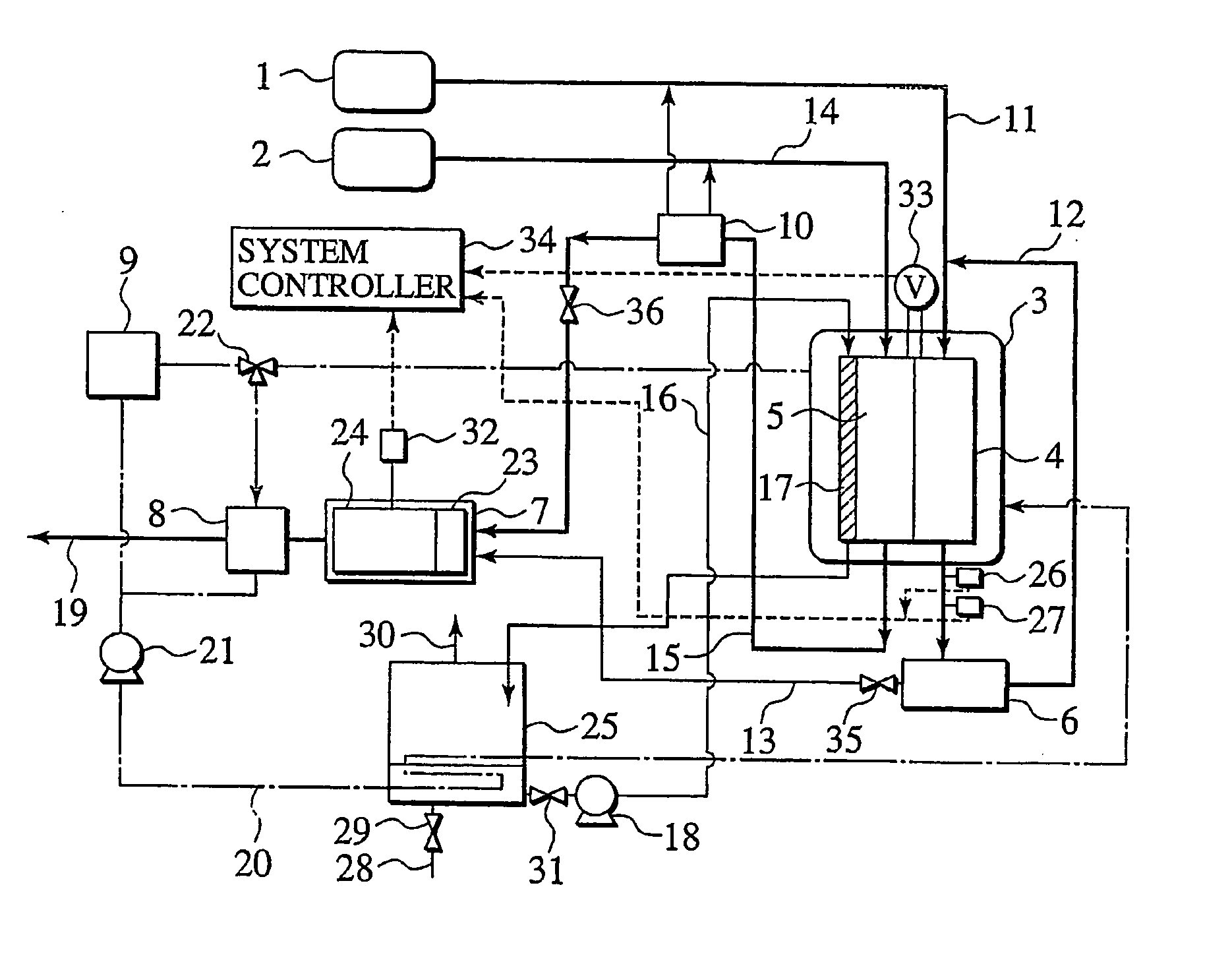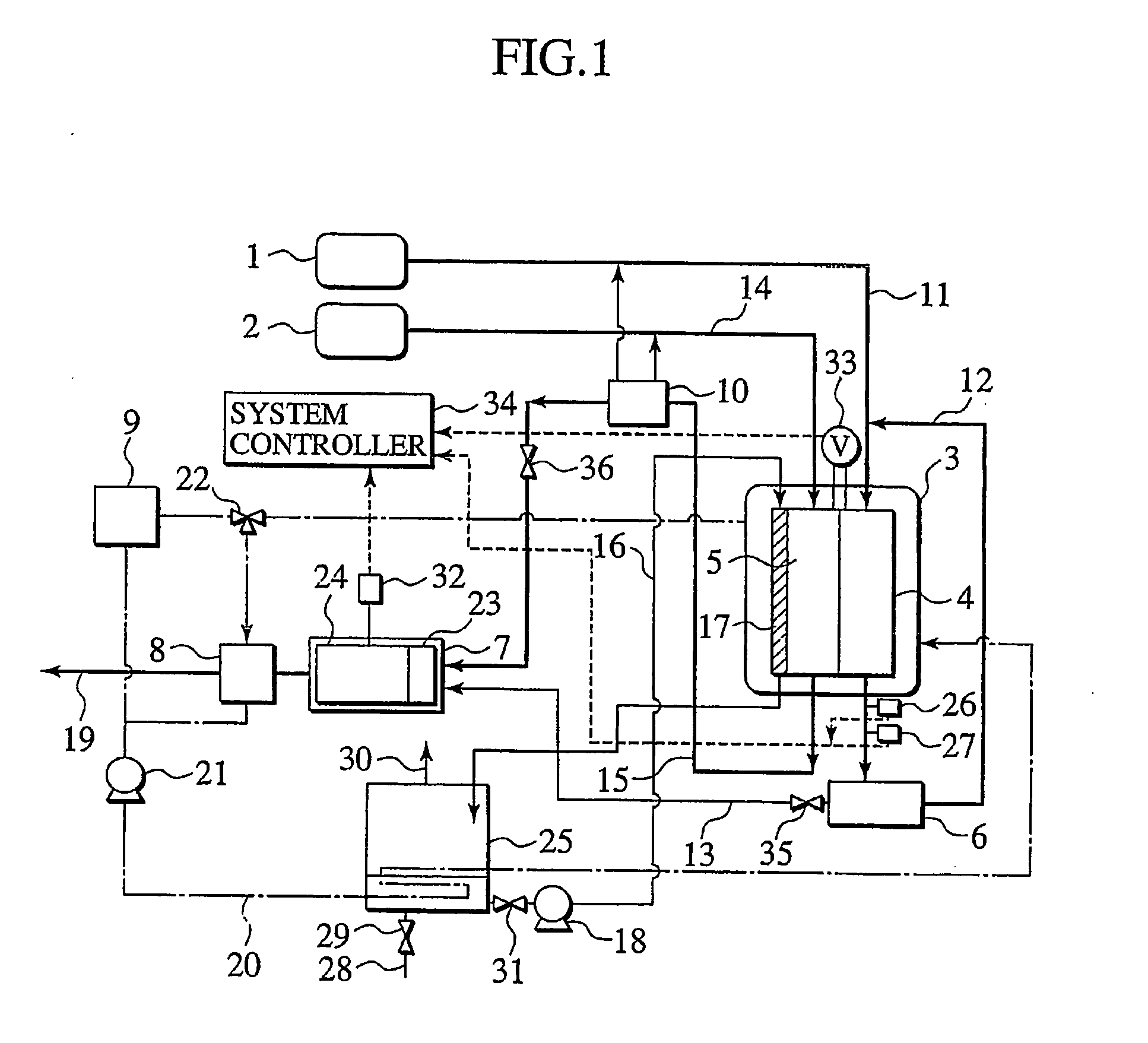Fuel cell system and fuel cell operating method
a fuel cell and operating method technology, applied in the field of fuel cell systems, can solve the problems of deteriorating reliability in a safety, requiring excessive size of the catalyst combustor, so as to reduce the amount of catalyst needed for processing fuel gas and improve heat energy recovery efficiency.
- Summary
- Abstract
- Description
- Claims
- Application Information
AI Technical Summary
Benefits of technology
Problems solved by technology
Method used
Image
Examples
first embodiment
[0016] Referring now to FIG. 1, FIGS. 2A to 2C and FIG. 3, a first embodiment of a fuel cell system according to the present invention is described in detail. FIG. 1 is a structural view of the fuel cell system of the first embodiment.
[0017] In FIG. 1, the fuel cell system of the presently filed embodiment is shown including a hydrogen supply unit (fuel gas supply unit) 1 that supplies hydrogen as fuel gas to an anode 4 of a fuel cell stack 3 through an anode gas supply conduit 11, and an air supply unit (oxidant gas supply unit) 2 that supplies air as oxidant gas to a cathode 5 through a cathode gas supply conduit 14. The fuel cell stack 3 is supplied with hydrogen and air to achieve electrochemical reaction for thereby generating electric power.
[0018] When this takes place, anode off-gas, that is not consumed in the anode 4, is expelled from the anode 4, and cathode off-gas resulting from a portion of oxidant gas consumed in the cathode 5 and containing moisture created through ...
second embodiment
[0044] Next, referring to FIGS. 4A to 4C and FIG. 5, description is made of a fuel cell system of a second embodiment of the present invention. The fuel cell system of the second embodiment is similar in structure to that shown in FIG. 1, with like component parts bearing the same reference numerals for a simplicity of description.
[0045] The fuel cell system of the presently filed embodiment differs from that of the first embodiment in that during the ignition period, no incremental operation for the air flow rate is performed and the system controller (control means) 34 controls in a way to intermittently supply anode off-gas at given time intervals shorter than the ignition time period.
[0046]FIGS. 4A to 4C are timing charts for illustrating how the system controller 34 forming part of the second embodiment controls a hydrogen concentration of mixed gas to be supplied to the catalytic combustor 7, with FIG. 4A representing the concentration of hydrogen supplied to the catalytic c...
third embodiment
[0067] Next, referring to FIGS. 6A to 6C and FIG. 7, description is made of a fuel cell system of a third embodiment of the present invention. The fuel cell system of the third embodiment is similar in structure to that shown in FIG. 1.
[0068] The fuel cell system of the presently filed embodiment differs from that of the first embodiment in that the flow rate of anode off-gas is increased based on a hydrogen concentration incremental pattern, that is preliminarily obtained for the ignition period, so as to allow the hydrogen concentration in mixed gas to transiently vary from the lower concentration than the flammable lean-limit to the higher concentration than the flammable lean-limit and to allow the average hydrogen concentration during the ignition period to fall in a value above the concentration at which the combustion temperature reaches a value greater than the activating temperature of the catalytic combustor 7 and at the hydrogen concentration (of 4%: here, for instance, ...
PUM
| Property | Measurement | Unit |
|---|---|---|
| electric power | aaaaa | aaaaa |
| concentration | aaaaa | aaaaa |
| flow rate | aaaaa | aaaaa |
Abstract
Description
Claims
Application Information
 Login to View More
Login to View More - R&D Engineer
- R&D Manager
- IP Professional
- Industry Leading Data Capabilities
- Powerful AI technology
- Patent DNA Extraction
Browse by: Latest US Patents, China's latest patents, Technical Efficacy Thesaurus, Application Domain, Technology Topic, Popular Technical Reports.
© 2024 PatSnap. All rights reserved.Legal|Privacy policy|Modern Slavery Act Transparency Statement|Sitemap|About US| Contact US: help@patsnap.com










